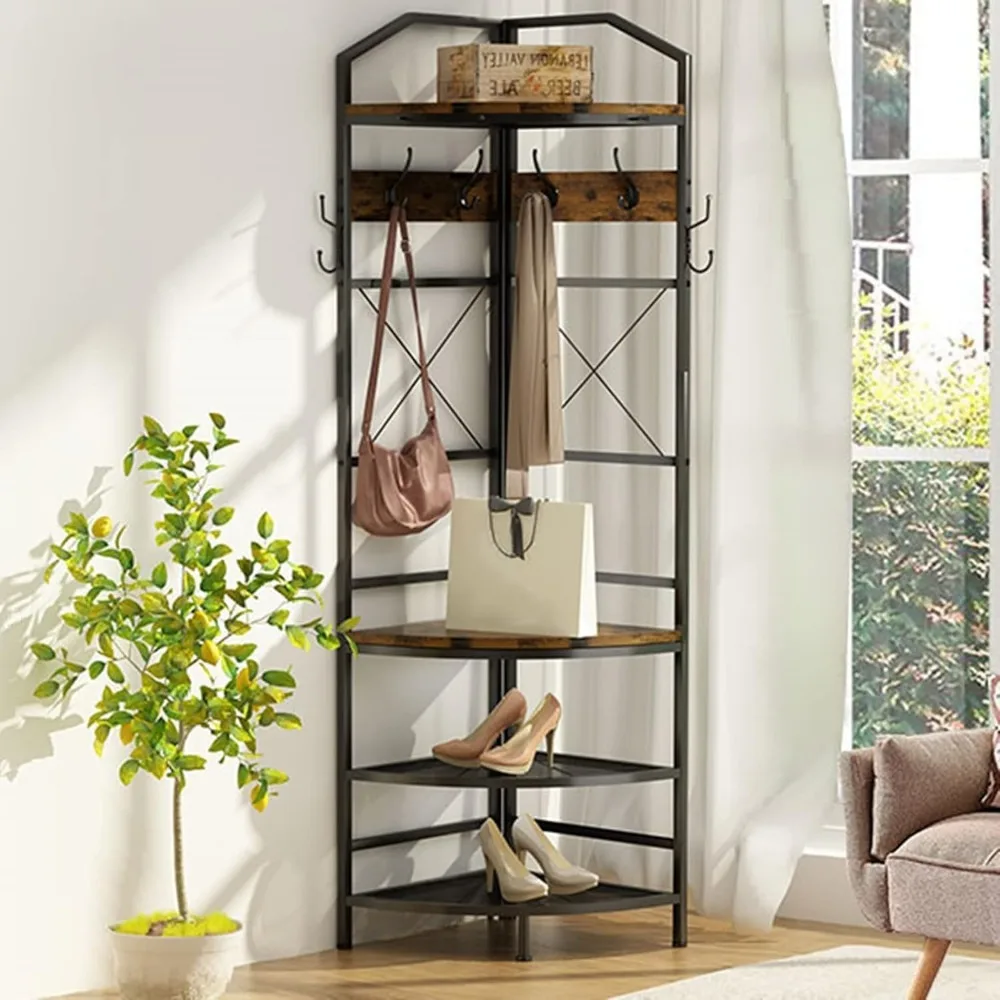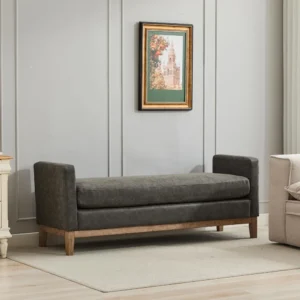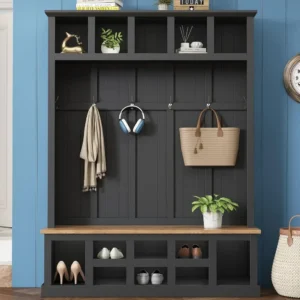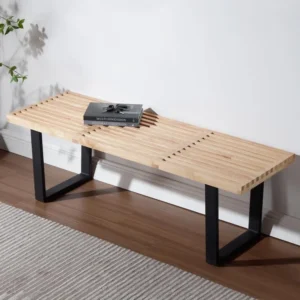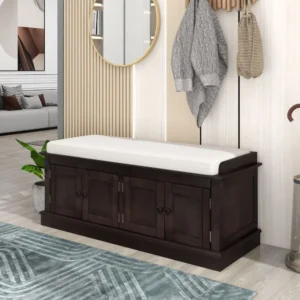Introduction
When square footage is at a premium, creating a functional mudroom might seem like an impossible luxury. Yet, these transition spaces between outdoors and in are essential for maintaining an organized, clean home—especially during messy weather seasons. The secret to making a compact mudroom work lies in thoughtful design centered around a multifunctional anchor: the bench.
A well-designed mudroom bench serves multiple purposes simultaneously—providing seating for removing shoes, offering storage underneath, and creating a visual focal point that brings style to utility. Even the most cramped entryway can be transformed into an efficient organization hub with the right approach.
The challenge of limited space actually presents an opportunity to be more intentional with design choices, focusing on pieces that deliver maximum functionality per square inch. Innovative space-saving entryway benches can turn that cluttered corner or narrow hallway into a mudroom that feels both spacious and purposeful. In the following sections, we’ll explore how to create these transformative spaces regardless of the constraints you’re working with.
Understanding Your Space: Planning a Compact Mudroom
Before selecting furniture or storage solutions, understanding your specific spatial constraints is crucial. A “compact” mudroom typically refers to areas ranging from just a few square feet up to about 30 square feet—often found in narrow hallways, entryway corners, converted closets, or even carved-out kitchen nooks.
Successful planning begins with these essential steps:
- Precise measurements: Document width, depth, and height of your available space, including any unusual angles or obstacles
- Traffic flow analysis: Allow at least 36 inches of clearance for comfortable passage through doorways and walkways
- Obstacle inventory: Note the location of electrical outlets, light switches, heating vents, and windows that need accommodation
- Household needs assessment: Consider how many people will use the space and what specific items need storage
- Priority ranking: List must-have functions (seating, shoe storage, coat hooks, etc.) in order of importance
The key to maximizing compact spaces is thinking vertically. When floor space is limited, walls become your most valuable asset. A thoughtfully designed wall system can utilize space from floor to ceiling, while a bench anchors the entire arrangement and provides essential functionality.
Knowing how to properly organize a small entryway bench area can make even the most constrained space feel purposeful rather than cramped. The goal isn’t just storage—it’s creating a smooth transition between outdoors and the clean interior of your home.
Built-In Bench Solutions: Maximizing Every Inch
Built-in benches offer unparalleled efficiency for compact mudrooms because they can be precisely tailored to your space’s exact dimensions. These custom solutions eliminate wasted gaps that often occur with freestanding furniture, making them ideal for maximizing limited square footage.
Built-In Bench Configurations for Small Spaces
- Full-width installations: Spanning wall-to-wall to utilize every horizontal inch while creating a built-in look
- L-shaped corner benches: Perfect for awkward corners that would otherwise become wasted space
- Floating designs: Mounted to the wall without visible legs, creating visual openness underneath that makes the room feel larger
- Window-seat conversions: Transforming existing window areas into functional seating with storage
For proper functionality, built-in benches should maintain a seat height of 17-19 inches (the standard height for comfortable sitting) and a depth of 15-18 inches. Shallower depths can work in extremely narrow spaces but may sacrifice some comfort.
Material selection becomes particularly important for built-ins since they’re permanent fixtures. Opt for moisture-resistant options like painted wood with marine-grade finishes or composite materials that withstand the wet boots and umbrellas that inevitably accompany mudroom use.
Under-bench storage should be designed with specific items in mind—consider pull-out baskets for hats and gloves, divided compartments for shoes, or even hinged seat tops for accessing larger storage areas beneath. Smart entryway bench solutions that incorporate multiple functions can deliver remarkable utility in surprisingly small footprints.
Versatile Freestanding Bench Options
While built-ins offer custom precision, freestanding benches provide flexibility, potential cost savings, and the ability to take your storage solution with you if you move. For compact mudrooms, selecting the right scale and style of freestanding bench can make all the difference.
The most space-efficient freestanding options include:
- Hall trees with integrated design: All-in-one units featuring bench seating, coat hooks, and often shelving or cubbies above
- Storage benches with lift-tops: Providing hidden interior storage that keeps visual clutter to a minimum
- Slim-profile designs: Specialized narrow benches just 12-14 inches deep for extremely tight spaces
- Shoe storage benches: Units with designated compartments, cubbies, or racks specifically designed for footwear organization
For compact spaces, look for benches less than 48 inches wide, which can still provide adequate seating while fitting into smaller footprints. Pay special attention to the overall dimensions relative to your available space, ensuring at least 24 inches of clearance for comfortable seating.
Material selection for freestanding pieces should prioritize durability and moisture resistance. Look for solid wood construction with protective finishes, metal frames that won’t warp when wet, and water-resistant upholstery if choosing cushioned options.
Our collection of mudroom benches offers various configurations specifically designed to address the constraints of compact spaces while maintaining both style and functionality.
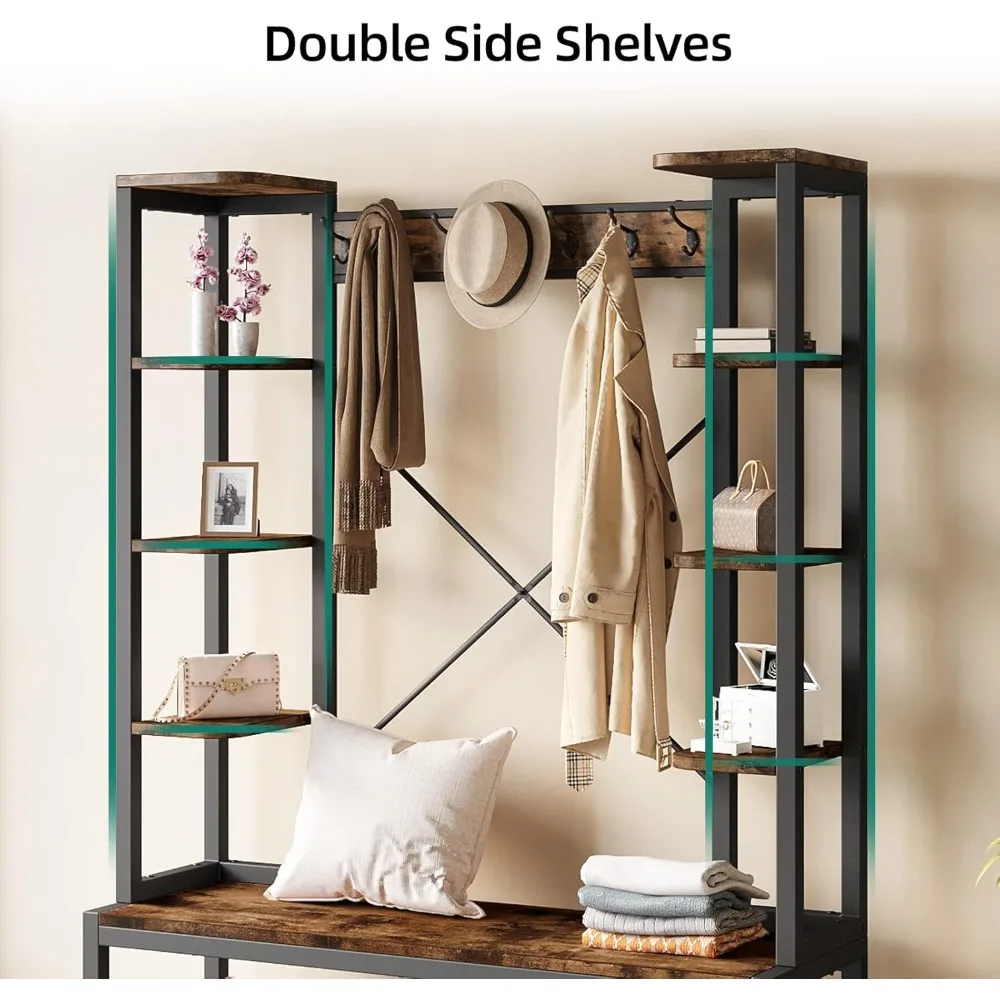
Innovative Storage Integration Above and Around Benches
The true potential of a compact mudroom is unlocked when you effectively utilize the vertical space above and around the bench. This approach multiplies your storage capacity without expanding the footprint.
Strategic Vertical Storage Solutions:
- Tiered hook systems: Install hooks at multiple heights (adult and child levels) to maximize wall space
- Floating shelves: Position 12-16 inches above the bench for baskets, seasonal items, or decorative elements
- Wall-mounted cubbies: Individual storage spaces that can be assigned to different family members
- Overhead cabinets: Closed storage that hides visual clutter while utilizing ceiling-adjacent space
- Behind-door solutions: Specialized organizers that take advantage of often-overlooked door surfaces
For proper functionality, install hooks approximately 60-65 inches from the floor for adults and 40-45 inches for children. Allow about 6-8 inches of space between hooks to prevent overcrowding.
The decision between open and closed storage impacts both function and aesthetics. Open systems provide immediate visibility and easier access, while closed storage conceals visual clutter—an important consideration in small spaces where visual noise can make rooms feel smaller.
Bench designs with integrated cubbies provide an elegant solution by combining seating and storage in a cohesive unit, often with designated spaces above for coats and bags. These systems create a complete organization station without requiring additional floor space.
Smart Shoe Storage Solutions for Compact Spaces
Footwear often presents the biggest organizational challenge in mudrooms due to its bulk, variety, and tendency to track in moisture and dirt. Compact spaces require especially clever solutions to manage this challenge.
Space-Efficient Shoe Organization:
- Under-bench compartments: Open cubbies or pull-out drawers that utilize the space beneath seating
- Vertical rack systems: Wall-mounted solutions that display shoes sideways to minimize depth requirements
- Tiered organizers: Multi-level systems that maximize storage capacity in a small footprint
- Specialized boot trays: Low-profile solutions for wet footwear that contain moisture and debris
For proper capacity planning, allocate approximately 5-6 inches of width per pair of adult shoes in standard storage. Boot storage requires about 8-10 inches of width and additional height considerations.
Materials for shoe storage areas should prioritize moisture management and easy cleaning. Look for metal racks that allow air circulation, plastic trays that can be wiped down, or slatted wooden designs that won’t trap moisture.
Mudroom benches with dedicated shoe storage combine seating with organized footwear solutions—a perfect pairing for compact spaces where every piece must serve multiple functions.
Entryway Bench with Cushion, Mudroom Bench with Cushion, Shoe Bench for Entryway
$1,186.63 Select options This product has multiple variants. The options may be chosen on the product pageCoat Rack Shoe Bench, Corner Entryway Bench, Corner Hall Tree, Shoe Bench for Entryway
$313.58 Select options This product has multiple variants. The options may be chosen on the product pageBench with Hooks and Storage, Entryway Hall Tree, Mudroom Bench with Cubbies, Mudroom Bench with Shoe Storage
$818.38 Select options This product has multiple variants. The options may be chosen on the product pageModern Entryway Bench, Wood Entryway Bench, Wood Mudroom Bench
$497.69 Select options This product has multiple variants. The options may be chosen on the product pageEntryway Coat Rack Bench, Entryway Hall Tree, Farmhouse Mudroom Bench, Mudroom Bench with Shoe Storage
$805.09 Select options This product has multiple variants. The options may be chosen on the product pageEntryway Bench with Cushion, Mudroom Bench with Cabinets, Shoe Bench for Entryway, Shoe Bench with Cushion
$991.71 Select options This product has multiple variants. The options may be chosen on the product page
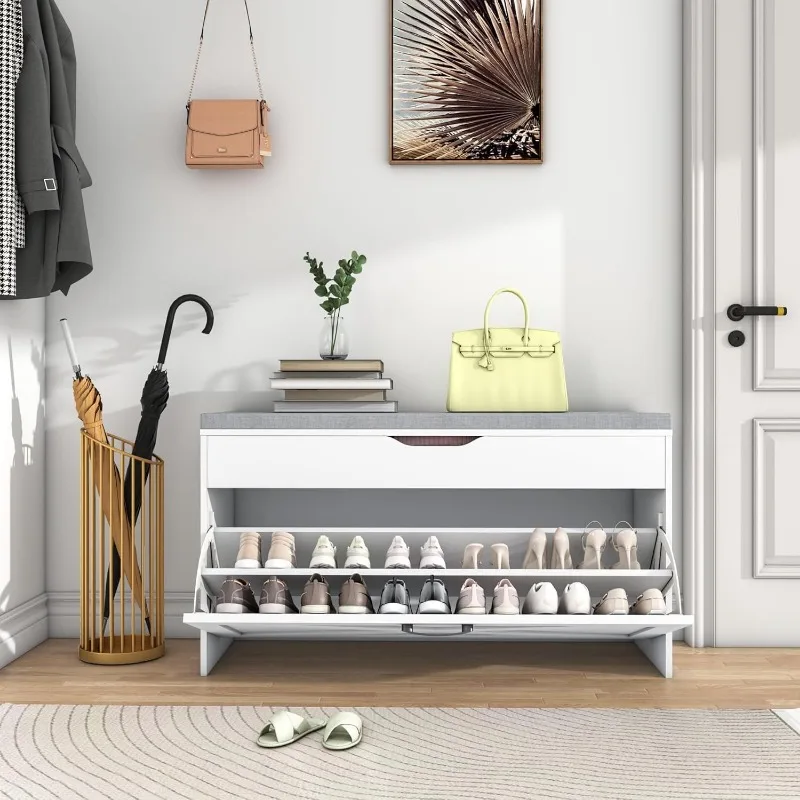
Materials and Finishes: Durability Meets Design
The materials you select for a mudroom must withstand daily traffic, moisture, and occasional rough treatment while still contributing to your home’s aesthetic appeal. This is especially true in compact spaces where each element is highly visible.
Comparative Bench Materials for Mudrooms
| Material | Durability | Moisture Resistance | Maintenance | Best For |
|---|---|---|---|---|
| Solid Hardwood | High with proper finish | Moderate to Good | Regular cleaning and occasional refinishing | Traditional and farmhouse styles |
| Metal and Wood | High | Very Good | Wipe-clean surfaces | Industrial and modern designs |
| Engineered Wood | Moderate to High | Good with proper sealing | Easy cleaning, avoid excess moisture | Budget-conscious projects |
| Plastic/Composite | Very High | Excellent | Simple wipe-down | Utility-focused mudrooms |
For flooring, prioritize water-resistant options like porcelain tile, luxury vinyl, or sealed concrete. Wall treatments should include washable paint (satin or semi-gloss finish) or beadboard with protective sealing to handle scuffs and cleaning.
Bench finishes require special attention since they contact both clothing and skin. Choose non-toxic, durable options like polyurethane for wooden surfaces or powder-coating for metal components. For upholstered elements, select outdoor-grade fabrics or removable, washable covers.
Our collection of wooden mudroom benches offers the warmth of natural materials with finishes specifically designed to handle mudroom conditions, balancing beauty with practicality.
Design Strategies: Making Small Mudrooms Feel Spacious
Strategic design choices can transform even the tiniest mudroom from cramped to comfortable through visual techniques that enhance perceived space.
Space-Enhancing Design Approaches:
- Color strategy: Light neutrals for walls and large surfaces to reflect light and create openness
- Visual continuity: Consistent flooring that flows from adjacent rooms to avoid visual breaks
- Strategic mirrors: Placed to reflect light and create the illusion of doubled space
- Simplified palette: Limiting color scheme to 2-3 complementary tones to reduce visual complexity
- Scaled furnishings: Selecting bench and storage pieces properly proportioned to the space
Lighting becomes critical in compact areas—inadequate illumination can make small spaces feel cave-like and unwelcoming. Layer lighting with:
- Overhead fixtures for general illumination
- Task lighting near hooks and bench areas
- Accent lighting to highlight architectural features or decorative elements
The principle of “less is more” applies strongly to compact mudrooms. Each item should earn its place through multi-functionality rather than purely decorative purpose. Implementing these space-saving entryway ideas can make even the most constrained area feel intentionally designed rather than compromised.
Personalization: Creating a Welcoming Entrance
Functionality doesn’t have to mean sacrificing personality. Small touches can transform a utilitarian mudroom into a space that reflects your home’s character while still maintaining practicality.
Consider these personalization approaches:
- Bench cushions: Select performance fabrics in patterns or colors that complement your home’s palette (Sunbrella, Crypton, or outdoor fabrics offer stain and moisture resistance)
- Basket liners: Fabric-lined storage baskets add softness and color while remaining highly functional
- Wall décor: Choose moisture-resistant artwork or photographs in sealed frames
- Personalized storage: Labeled hooks or cubbies for each family member add organization and personal touch
- Seasonal elements: Small, rotating decorative items that reflect the current season without consuming valuable space
The entryway creates the first impression of your home for both residents and guests. Even functional elements can be selected to align with your overall aesthetic—whether farmhouse, modern, traditional, or eclectic.
Understanding the full potential of multi-functional mudroom benches allows you to select pieces that not only serve practical purposes but also enhance your home’s character and reflect your personal style.
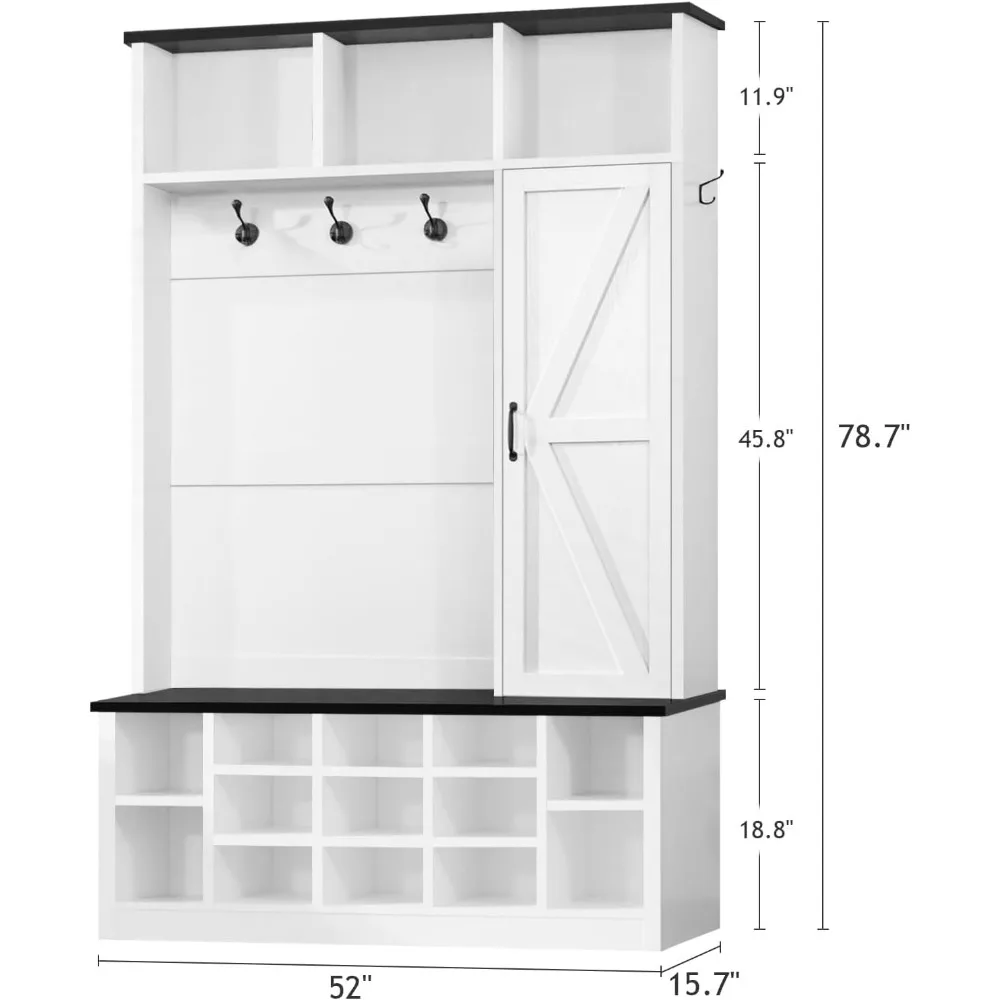
Frequently Asked Questions About Compact Mudroom Benches
What is the minimum space needed for a functional mudroom bench?
A basic functional mudroom setup can work in as little as 3 feet of width and 20 inches of depth—enough space for a narrow bench and hooks above. For more comfort and functionality, aim for at least 4 feet wide if possible.
How do you keep a small mudroom from looking cluttered?
Implement consistent storage solutions with designated places for each item, use closed storage when possible, limit decorative items, and maintain a disciplined approach to what items are allowed to accumulate in the space.
Can a mudroom bench work in a hallway less than 4 feet wide?
Yes, with specialized narrow benches as slim as 12 inches deep. When combined with wall storage above, even narrow hallways can function effectively as mudrooms without impeding traffic flow.
What’s the best bench height for comfortable shoe removal?
The optimal bench height is 17-19 inches from the floor, which matches standard chair height and allows comfortable sitting for most adults while removing footwear.
How can I maximize storage in an extremely small mudroom?
Focus on vertical solutions, utilize multi-functional pieces, implement storage systems inside cabinet doors, and consider seasonal rotation of items to store only what’s currently needed. Our space-efficient mudroom solutions provide additional specialized options for extremely constrained spaces.
Real-Life Transformations: Compact Mudroom Success Stories
Narrow Hallway Revival
A 3.5-foot wide hallway was transformed from a bottleneck into a functional entry point by installing a slim 14-inch deep bench along one wall, with a vertical system of hooks and small floating shelves above. The opposite wall received a mirror that visually doubled the perceived space. The transformation not only improved organization but eliminated the daily pile-up of shoes and bags on the floor.
Closet Conversion Wonder
An underutilized coat closet measuring just 36 inches wide was reimagined as a compact mudroom. The doors were removed, and a custom bench was built into the base with divided storage underneath. The interior sides and back wall received hook systems at multiple heights, while the upper portion maintained a shelf with baskets for seasonal items. This conversion actually increased the functional storage capacity while providing a dedicated place for removing and storing shoes.
Corner Space Maximizer
A formerly awkward corner near a side entrance was transformed with an L-shaped bench design that wrapped perfectly into the space. The corner installation provided seating from two approaches and created more usable storage than a straight bench would allow. Corner hall tree solutions like this one demonstrate how seemingly awkward spaces can become some of the most functional areas of the home with the right design approach.
Where to Find Quality Compact Mudroom Furnishings
When shopping for compact mudroom furniture, quality indicators become especially important as these pieces will face daily use in challenging conditions. Look for solid joinery techniques like dovetail or mortise-and-tenon connections rather than just glue or staples. Hardware quality is also crucial—drawer slides should be smooth, hinges substantial, and all metal components resistant to rust.
For extremely narrow spaces, specialized narrow entryway benches offer dimensions specifically designed to fit in constrained areas without sacrificing functionality. These pieces are engineered to maximize utility in minimal footprints.
Features worth investing in include soft-close mechanisms for drawers and cabinets, water-resistant finishes, and adjustable components that can adapt as your needs change. Remember that precise measurements are essential—be sure to account for baseboards, door swing paths, and any other factors that might affect fit.
Conclusion: Transform Your Entryway with a Well-Designed Compact Mudroom
A thoughtfully designed compact mudroom with an integrated bench creates organization and style in even the most limited spaces. By focusing on vertical storage, multi-functional pieces, and appropriate materials, your small entryway can deliver impressive utility while enhancing your home’s appearance. The key is intentional planning that prioritizes your household’s specific needs while making every square inch count. With these strategies, you can transform that challenging small space into one of the most functional and welcoming areas of your home.

